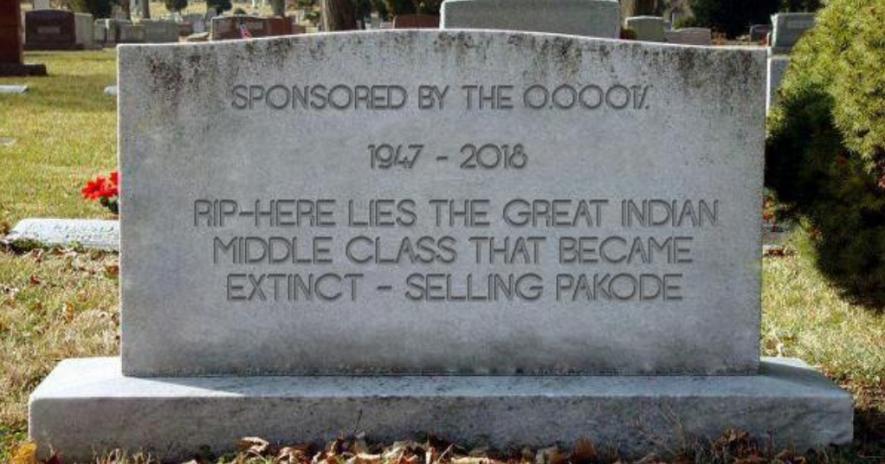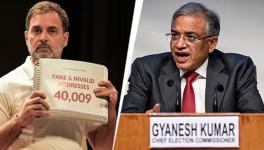Delusions of the Dwindling Indian Middle Class

Writing in the Globe and Mail the Delhi based journalist Amrit Dhillon paints a despairingly gloomy picture of the Indian middle class. To quote, “That class is a strange creature. It has always been different from its counterpart in other countries. For a start, it is lowbrow. Middle-class Indians, in general, have little interest in classical music, literature, theatre or any cinema except Bollywood. Their hobbies are shopping and visiting relatives. Sit in the departure lounge of any airport in India or in the trains patronized by the affluent, and you will hardly ever see anyone with a book in their hands. Intellectual pursuits are shunned. Engaging with ideas is alien. They do not, as other middle classes do, set the agenda of public debate, or help to form public opinion and lead public discourse on issues of the day. That is left to India's minuscule elite of academics and intellectuals.”
This unflattering assessment of the middle class may anger many but it is unfortunately bang on in summing up the social behavior of the middle class. A bitter pill to swallow is the fact that the middle class role model has more negative aspects than positive ones. For instance the middle class is apathetic to its civic duties. This is seen during elections when long queues of the poor are seen in polling stations while fewer people from the urban middle class actually vote or participate meaningfully in the political process. Instead they wallow in self importance of having arrived in a competitive world by virtue of their hard work and education. The rural and urban poor, according to middle class opinion, have themselves to blame for their miserable condition of destitution and poverty.
Moreover a significant number of the middle class veer towards authoritarian power structures to keep the clamouring masses seeking social justice in check so that their path to infinite prosperity remains unimpeded. Being intellectually lazy and inactive in politics, large sections of the middle class need ‘strong leaders’ who will crack heads and keep the unruly mob in line. This perhaps explains their craven masochistic love for dictators.
The Indian middle class also adopted conspicuous consumption to buttress their sense of fragile status and privilege. As Jon P Dorschner acidly observes “In many cases this conspicuous consumption outstrips the legitimate income of the middle class consumer and in reality much of this consumption is funded by corruption. In a country where corruption is widespread, the Indian middle class fully participates in the consumerism/corruption nexus.”
In general the lack of empathy of the middle class towards the politics of redistribution of wealth by taxing the extremely rich was viewed negatively as Commie talk and wasting tax payer’s money on freeloaders and losers. This derisive contempt drove the middle class to enthusiastically support neo-liberal economic agenda of Indian Business family and Corporate elite interests.
The neo-liberal economic agenda- backed by the middle class- refers to slew of measures which included reduction or elimination of trade unions, reduction of trade barriers, reducing government role in the economy (cutting the red tape), reduction in welfare spending, privatization of the public sector, tax reduction, the creation of export zones, tax holidays, easing repatriation of profits earned by foreign companies and tax holidays for foreign investors.
Associated with economic neo-liberalism was the rather hare-brained notion that once the pie (ie the GDP) grew the benefits would trickle down to the economy by expansion leading to job creation and all round prosperity.In the media the miraculous success of the trickledown effect of neo-liberal economics was announced in unmeasured hyperbole. Media persons fell over each other in a swoon to announce that the sleeping beauty called the middle class had finally woken up- at least 250-300 million of them. Economists breathlessly hyperventilated that nearly 40% per cent of the population (283 million for the year1989-90) had broken through the shackles of poverty. Trade liberalization soon followed filling the shopping bags of middle class consumers with electronic gadgets and status enhancing imported goods.
The media spin about the rising middle class was a ploy to serve the ideological agenda of neo-liberalism that class polarization into the rich and poor had been averted as sizable portion moved from poverty to the status of becoming middle class. Those laggards who had been left behind, as the propaganda suggested, had themselves to blame for their apathy, lack of education and lack of drive. The welfare state with its expenditure on social sectors like health and education only bred a parasitic class perpetually begging and had to be gutted.The middle class having fallen hook line and sinker to the media spin tragically misaligned their interests to neo-liberal economics enforced in an authoritarian manner. In doing so have they been unwittingly complicit in signing their own death warrant?
For the past twenty years the neo-liberal economic package implemented by both the main political parties namely Congress and BJP under Modi only served the interests of the rich Business Oligarchs and Corporate interests. There were differences only in the mood music while implementing neo-liberalism. With the Congress neo-liberalism was thrust upon the populace with slogans such as inclusive growth. With the Modi Government it was dished out with dollops of militarism, communal violence, cow vigilantism and religious obscurantism. And of course the magical trickle down never happened to any significant extent.
Cutting through the hype that we are predominately middle class in India there is clinching evidence to the contrary. In a report prepared by French economists Thomas Piketty and Lucas Chancel titled Indian income inequality, 1922-2014: From British Raj to Billionaire Raj? debunk the cynical distortion in the stories about the rising middle class of India and show that economic liberalism has benefited 10% of the population especially the top 1% of the income earners. The authors of the report state- “This result should help us better characterize what has been termed as ‘the rise of India's middle class.’ From the perspective of our new income inequality dataset,“Shining India” corresponds to the top 10 percent of the population (approximately 80 million adult individuals in 2014) rather than the middle 40 percent. Relatively speaking, the shining decades for the middle 40 percent group corresponded to the 1951-1980 period, when this group captured a much higher share of total growth (49 percent) than it did over the past forty years. It is also important to stress that, since the early 1980s, growth has been highly unevenly distributed within the top 10 percent group.” [Emphasis added
There is also a reality check by looking at the material conditions in which people work. Here we find that the formal sector accounts for only 8% and rest lies in the informal sector which accounts for 92% where many toil in the twilight zone for a pittance. The relatively better paying jobs in the govt sector fell to 17.3 million by 2011. The Information Technology accounts for 2.8 million jobs constitute only 0.6 per cent of total employment. Finance, real estate and business services’ grew from 0.9 per cent of total employment in 1993-94 to 1.5 per cent in 2004-05 to 2.6 per cent in 2011-12.
The conclusion is clear “the data indicate that it falls well within the top 10 per cent of India’s workforce (i.e., the top 47 million workers). No doubt the absolute numbers involved are large. The top 5 per cent of India’s population (63 million) is larger than the population of most European countries, and the top 10 per cent (125 million) is larger than any European country. Hence the top 5-10 per cent are important to the marketing strategies of any international investor. But they cannot be the basis for a broader characterization of Indian society.”
Moreover, a phenomenon called the middle class squeeze is affecting the middle class in India. This is a situation where wages fail to keep pace with inflation leading to decline in real wages. Even the relatively better paid IT employees face job losses as the Tech companies face slowdown. Senior employees with better pay are sacked in favour of fresh recruits with lower salaries. The middle class income in metro cities face decline while goods and services are increasing .The gigantic suction pumps of housing, educationand healthcare suck away the disposable income of the middle class. Moreover, the rising fuel prices on account of rising prices in international market has increased the misery of the middle class while earlier lower prices of fuel was not passed on to the public by the Modi government.
The escape hatch for the well educated middle class possessing engineering degrees and working in tech companies appears to be closing as the gusty winds of protectionism from USA seem to be blowing their way in the form of restriction of H1B work permits. The way to wealth through the Silicon Road is not going to be a smooth one. The lack of allure of engineering courses is one direct result of the depressed demand in the US for overseas IT workers.
At risk are also senior citizens who have invested in Bank deposits of PSU banks which are having bad loans on account of profligate borrowing by business bigwigs which may never be paid. The Modi Government is including a bail in provision to the act which would ensure that the middle class depositors would pay for the bad debts of Rich Business Oligarchs.
The election of Modi who was widely seen as a Messiah of Vikas by the admiring middle class failed to bring cheer. His election promises proved to be mere jumla (empty promises). His badly planned and executed measures of demonetization and GST pummeled middle class traders to ruin.
For those of the middle class who voted for Narendra Modi for jobs and development- would be dismayed to learn what he really thought about job prospects. When a reporter of a news channel asked him why there were no jobs- Modi replied with refreshing candour- There are jobs if you sell pakode.
Modi’s reply must have come as a damp squib to the Middle Class who’d been promised millions of jobs during Modi’s election rallies.Once it dawned upon the Middle Class that their Brave New World was one with a stagnant job market and that their only occupation would be the prospect of hauling hand carts and selling pakoda with mint chutney, a strong sense of betrayal and anger pervaded the Middle Class which erupted in angry messages being directed against the Messiah on social media.
Neo-liberal economics has come full circle.Now the Aspiring Middle Class has become the Perspiring Middle Class hauling carts and selling pakode. This bitter taste of entrepreneurship was never envisaged by even the most credulous members of the middle class.

Perhaps in a dystopian world of extreme inequality the fitting epitaph for the middle class would be given out of a sense of noblesse oblige by the 0.0001% left standing .This would be in the form of a tombstone inscribed with the words- Here lies the Great Indian Middle Class that became extinct - Selling Pakode.
"Delusions of the Dwindling Indian Middle Class":
@sapientpen
Disclaimer: The views expressed here are the author's personal views, and do not necessarily represent the views of Newsclick.
Get the latest reports & analysis with people's perspective on Protests, movements & deep analytical videos, discussions of the current affairs in your Telegram app. Subscribe to NewsClick's Telegram channel & get Real-Time updates on stories, as they get published on our website.
























